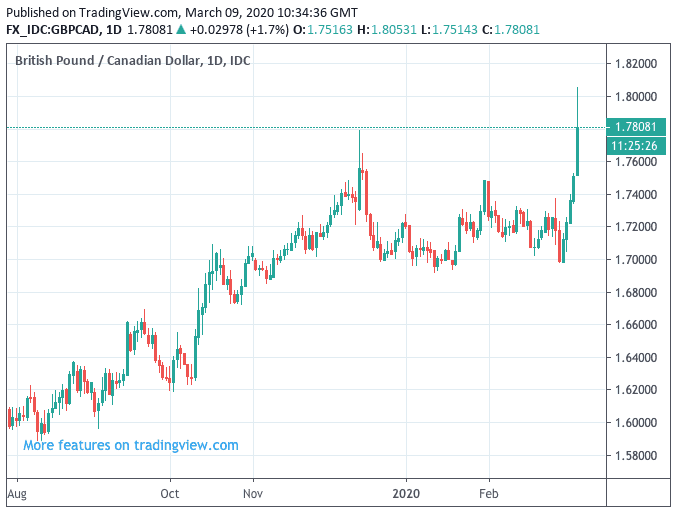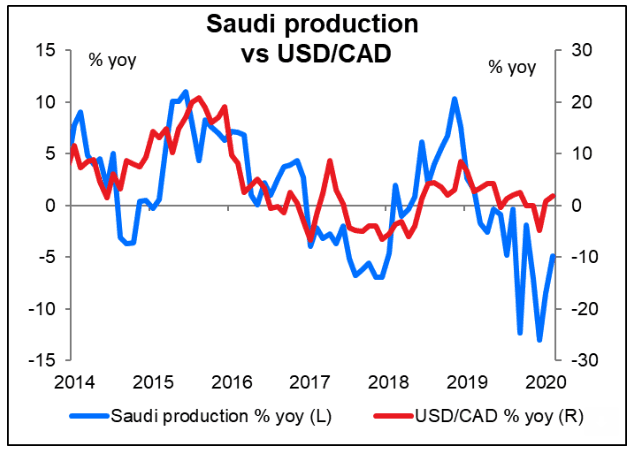Pound-Canadian Dollar at Best Rate since 2018 on Oil Price Plunge
- Oil price slump bites CAD
- Can get weaker says strategist
- GBP/CAD spiked to 1.80 earlier in the day
- Oil prices can fall to $25 say MUFG

Image © Adobe Stock
- GBP/CAD spot: 1.7817, +1.84
- Bank transfer rates: 1.7209-1.7334
- FX specialist rates: -1.7600-1.7673 >> More information
The Pound-to-Canadian Dollar exchange rate leapt 1.8% in Monday trade as a meltdown in global stocks and oil prices left the Canadian Dollar as one of the FX market's major losers.
Oil exports form a major part of Canada's export basket and is the country's single most important foreign exchange earner and a 0.30% fall in the value of global crude prices ultimately undermines a pillar of value for the Canadian Dollar.
The GBP/CAD exchange rate is at 1.78 at the time of writing - its highest level since April 2018 - but a spike earlier in the day saw the exchange rate go to 1.8053.

Oil prices plummeted at the start of trade after markets reacted to rising fears of a global recession, courtesy of measures to prevent the spread of the coronavirus, but mainly owing to the inability of OPEC+ to reach an agreement on limiting oil output.
Faced with the prospect of lower oil prices as a result of a global economic slowdown, OPEC+ attempted to agree oil production restrictions in order to ensure elevated oil prices. As a result of the failure Saudi Arabia committed to raising oil production to 10 million barrels a day, up from current levels of 9.7 million. Saudi Arabia had offered to cut production to 9 million.
"The kingdom will also offer unprecedented discounts of almost 20% in key markets, with the clear goal of taking market share away from Russia and inflicting pain on US shale producers," says Marshall Gittler, a market strategist at BD Swiss.
As a result WTI crude now trades 20% lower at $33 a barrel, Brent crude is down a similar margin at $36 a barrel. The knock-on effect of these losses is to push natural gas prices down 4% to $1.65.
"What does this mean for the currency market going forwards? For growth-sensitive and for oil-sensitive currencies, it's far too early to pick a bottom. NOK and CAD are going to get weaker, perhaps quite a lot weaker," says Kit Juckes, a foreign exchange strategist at Société Générale.
"We can expect the Saudi decision to be negative for CAD, which has enough problems of its own nowadays anyway. There is a rough correlation between the change in Saudi output and the USD/CAD rate, with USD/CAD tending to rise (i.e., CAD to weaken) as Saudi output rises. This is no doubt due to oil prices tending to fall when Saudi output rises," says Gittler.
Image courtesy of BD Swiss.
"You can see the effect particularly in 2014/2015, the last time Saudi Arabia unleashed such an oil price war by ramping up production. The impact on CAD was swift and clear, as it no doubt will be now as well," adds Gittler.
The Canadian Dollar's outlook could therefore now rest on the outlook for oil prices, and further significant declines are possible according to economists at global investment bank MUFG who have reacted to the surprising outcome of Friday's OPEC+ that saw oil producers fail to agree a deal on production cuts.
"The unthinkable has played out in what was an absolute emergency OPEC+ meeting between 5-6 March to assess the hit to global oil demand caused by COVID-19 – the highly tense OPEC+ meeting concluded with no deal to either extend or deepen output, after Russia held firm and did not commit to taking any action," says Ehsan Khoman, Head of MENA Research and Strategy at MUFG.
The two benchmark crude oils fell by over 30% at one stage following the opening of global markets on Monday, the largest daily decline since the lead up to the Gulf War of 1990.
Saudi Arabia have committed to increase output in April after Russia declined OPEC’s proposal to enact steep production cut. Saudi Arabia also cut its official crude selling price in what looks like a clear attempt to take market share from Russia and the U.S.
After all, Saudi Arabia is best placed to weather any falls in oil prices owing to the country's ease of extraction.
"We mark-to-market our entire quarterly 2020 oil price forecasts, reflecting the two highly uncertain simultaneous bearish shocks – a demand destruction caused by COVID-19 and a supply surge caused by the unequivocal oil price war started instigated over the weekend by OPEC and Russia," says Khoman. "In the first sign of the next steps, Saudi Arabia has kick-started an all-out price war, by offering unprecedented discounts for its April 2020 oil output contract (the deepest cuts in at least 20 years) for its main crude grades for European, Asian and US refiners, in a bid to entice them to purchase Saudi crude at the expense of other suppliers."
MUFG's models now forecast quarter-end 2020 levels for Q1, Q2, Q3 and Q4 2020 at $28.6 a barrel, $32.3/b, $35.6/b and $46.1/b, respectively.
For the second quarter of 2020 they do not rule out a protracted period of oil prices at operational pressure levels of below $30 a barrel.
"Brace for a world with no oil price floor and don’t rule out sub-USD25/b," says Khoman.





